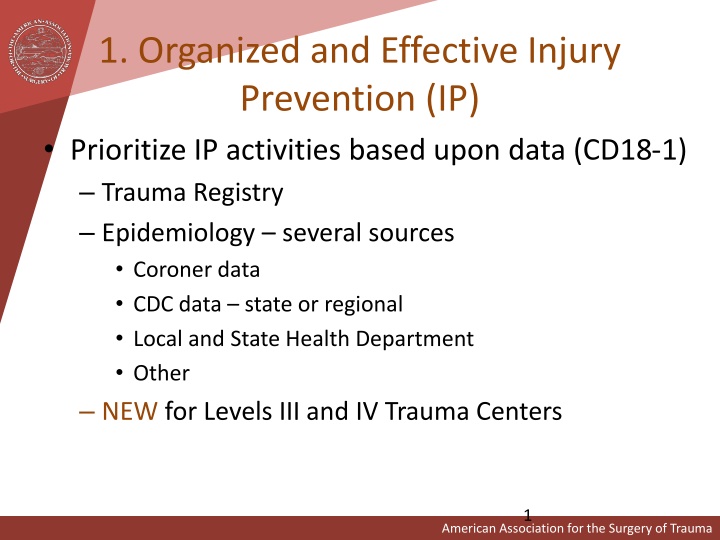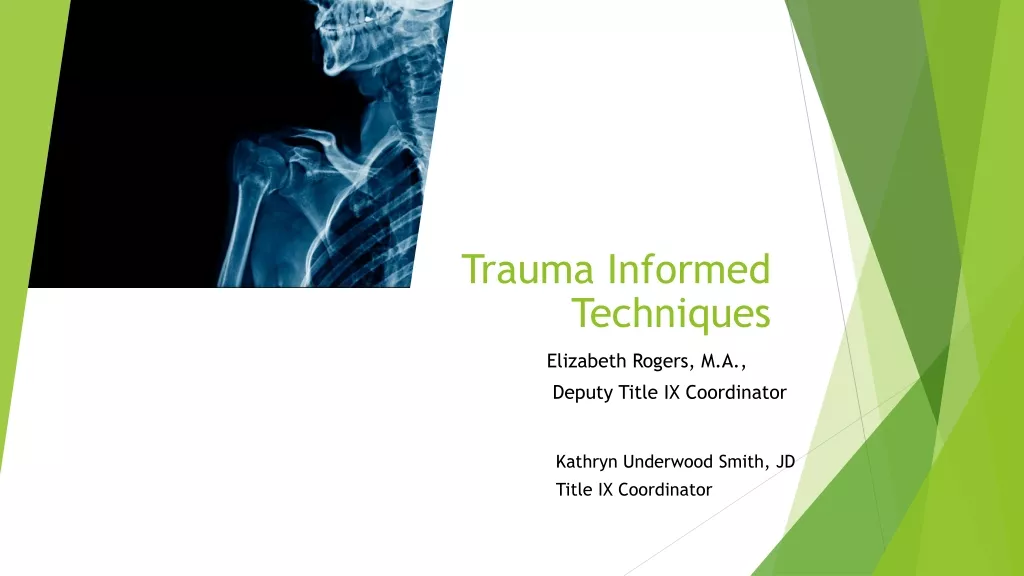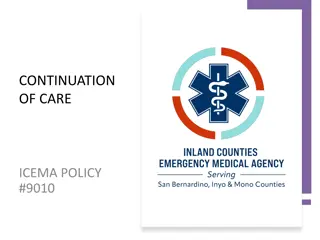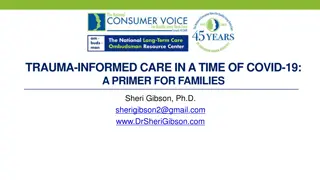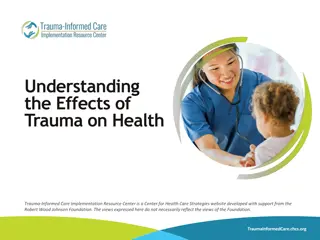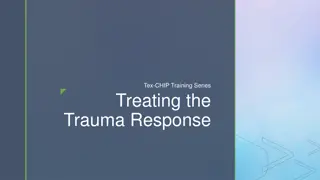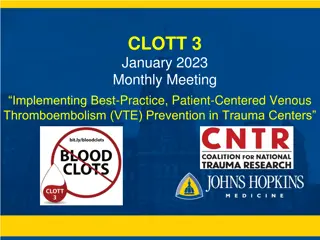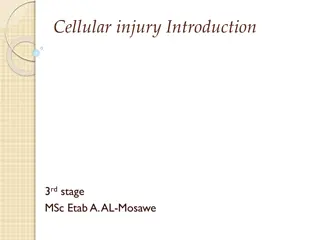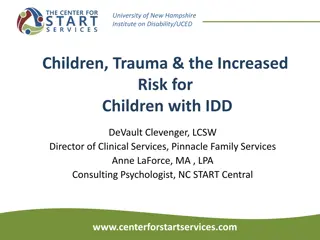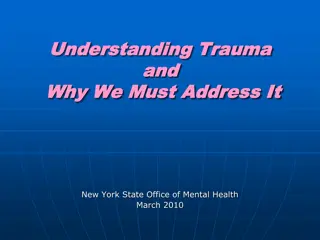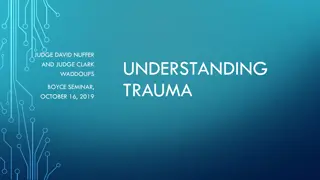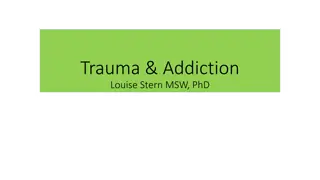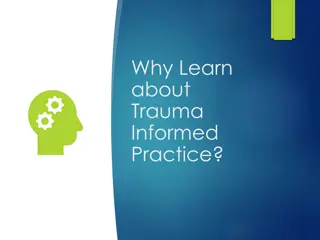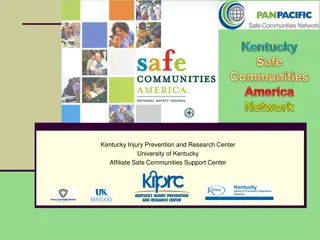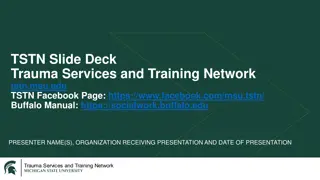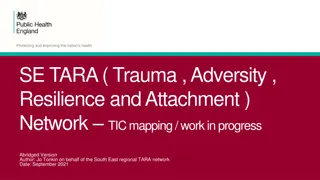Effective Strategies for Injury Prevention in Trauma Centers
Organized and data-driven injury prevention activities are crucial in trauma centers. Community partnerships, evidence-based reviews, designated injury prevention coordinators, and involvement of trauma personnel are key elements for successful injury prevention. Targeting contributing factors like drugs, alcohol, and behavioral issues is essential for effective injury prevention programs.
Download Presentation

Please find below an Image/Link to download the presentation.
The content on the website is provided AS IS for your information and personal use only. It may not be sold, licensed, or shared on other websites without obtaining consent from the author.If you encounter any issues during the download, it is possible that the publisher has removed the file from their server.
You are allowed to download the files provided on this website for personal or commercial use, subject to the condition that they are used lawfully. All files are the property of their respective owners.
The content on the website is provided AS IS for your information and personal use only. It may not be sold, licensed, or shared on other websites without obtaining consent from the author.
E N D
Presentation Transcript
1. Organized and Effective Injury Prevention (IP) Prioritize IP activities based upon data (CD18-1) Trauma Registry Epidemiology several sources Coroner data CDC data state or regional Local and State Health Department Other NEW for Levels III and IV Trauma Centers 1 American Association for the Surgery of Trauma
1. Organized and Effective Injury Prevention (IP) Community partnerships with experts in specific injury prevention; Exchange of data to better understand the root cause of the problem and how to intervene to decrease injury/death. Must be effective programs: Data driven Evidence based reviews (East, Cochrane, others) 2 American Association for the Surgery of Trauma
Sports Related Concussion Injury Prevention ... Sports Related Concussion Injury Prevention2015. Type: New Evidence Based Review (EBR) Category: Injury Prevention Section Liaison: Marie L. Crandall, MD, MPH. ... www.east.org/education/practice- management-guidelines/details/33/sports- related-concussion-injury-prevention American Association for the Surgery of Trauma
2. Effective Leadership Must be a designated injury prevention coordinator with a job description that includes IP (CD18-2) L1 must be a person separate from trauma program manager; must have salary support for IP L2-4 may be the trauma program manager (TPM) only if job description includes detailed responsibilities in IP and IP does not interfere with the other responsibilities of the TPM 4 American Association for the Surgery of Trauma
2. Effective Leadership TPM should be involved in IP Nurses, physicians and other trauma personnel should be involved in IP at all Trauma Centers 5 American Association for the Surgery of Trauma
3. Effective Injury prevention 3 most common causes of injury and traumatic death in trauma center community Target contributing factors: Drugs and alcohol Behavioral problems Education alone is not necessarily effective Target audience is not necessarily motivated and ready for change. 6 American Association for the Surgery of Trauma
Key Elements of EFFECTIVE Injury Prevention Program Target the community identify primary causes of injury and death Work upstream to develop the root cause of injury and its contributing factors Choose pre-existing proven or promising programs work with community groups Leverage the media to disseminate information on IP Program, why its important and how the public can help 7 American Association for the Surgery of Trauma
Key Elements of EFFECTIVE Injury Prevention Program Work with political leaders educate them and help them create laws that promote injury prevention. Follow data track prevention effectiveness 8 American Association for the Surgery of Trauma
Identifying causes of injury and death Required: 3 most common causes of injury and traumatic death in trauma center community Remember to work with coroner and others to identify very lethal causes of injury-related death that may not be in trauma database Examples: Suicide, falls from high construction sites Focus on the proximate cause alcohol and drug use are frequent contributors 9 American Association for the Surgery of Trauma
Identify Proximate Causes Screening and brief intervention for alcohol Required of all trauma centers (CD-3) Effective screening instrument (CDC, other) http://www.cdc.gov/ncbddd/fasd/alcohol-screening.html Cutoff Score How do you track Have all patients who screen positive received a brief intervention by trained personnel at Level I and II Trauma Centers? (CD-4) New for Level II How do you track and document? 10 American Association for the Surgery of Trauma
Identify Proximate Causes Screening for other drugs of abuse could benefit from research (suggestion!) Access to firearms Safe Storage Safe ownership Socioeconomic, cultural, environmental, engineering Example auto versus pedestrian 11 American Association for the Surgery of Trauma
Identify Proximate Causes Geriatric populations Falls, burns, auto pedestrian Domestic violence Proximate causes? Contributing causes? 12 American Association for the Surgery of Trauma
Teachable Moment Screening and brief intervention Alcohol and problematic drugs (Best practices) Levels 1 and 2 must screen by trained staff; must be documented (CD-3) How trained? What screening instrument Intervention or referral for patients identified? Required of Level 1 (CD-4) What type of intervention and how is it documented? 13 American Association for the Surgery of Trauma
Proven and Promising Programs Proven and promising others are using and/or researching with promising results Complete review of the literature (East, CDC, Cochrane) Adapt to your community Level 1 and Level 2 centers must implement at least 2 programs that address one of the major causes of injury in the community (CD-5) 14 American Association for the Surgery of Trauma
Proven and Promising Programs Track partnerships with community organizations (CD-6) Trauma Centers must partner Churches, law enforcement, community organizations that have injury prevention as their core mission (Tracking tools) Shared ownership with multiple community partnerships Link to regional and nation prevention efforts Government and non-government Collaborate with the media 15 American Association for the Surgery of Trauma
Documentation Target injury or root cause Date, location of program; target audience, numbers Trauma center resources Personnel hours Community partners and personnel hours Other financial support Elected officials involved; legislation Community members reached Outcome measures 16 American Association for the Surgery of Trauma
Examples Violence prevention MVC drinking and driving, restraints Auto Pedestrian Falls - #1 in the US CDC guidelines; Cochrane Review Suicide Domestic Violence 17 American Association for the Surgery of Trauma
Trauma Prevention Coalition POOLED RESOURCES American Association for the Surgery of Trauma
ACS COT Statements Statement on Firearm Injuries Statement on Bicycle Safety Statement on Motorcycle Helmet Use Statement on Non-traffic Statement on Geriatric Burn Prevention (In Progress) American Association for the Surgery of Trauma
Advocacy COT is working on toolkits utilizing national data and you can add local data. Examples: Primary seat belt legislation Child Booster Seat legislation Speed legislation Motorcycle helmet legislation American Association for the Surgery of Trauma
